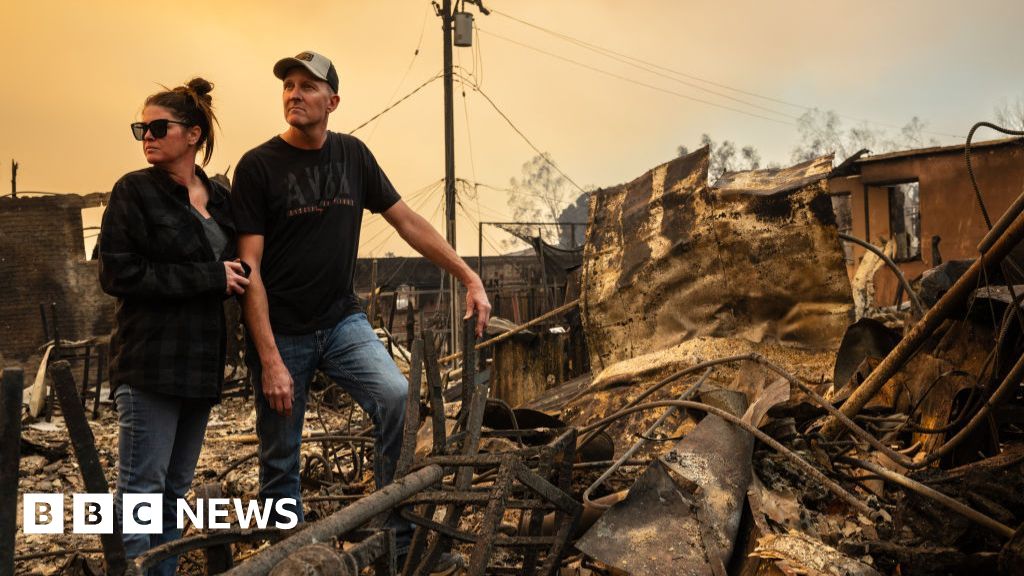 Image source, Getty Images
Image source, Getty Images
By Mark Poynting & Marco Silva
BBC News
Dubai has been hit by record floods over the past 24 hours, sparking misleading speculation about cloud seeding.
So how unusual was the rainfall and what were the reasons behind the extreme downpours?
How extreme was the rainfall?
Dubai is situated on the coast of the United Arab Emirates (UAE) and is usually very dry. But while it receives less than 100mm (3.9in) a year of rainfall on average, it does experience occasional extreme downpours.
In the city of Al-Ain - just over 100km (62 miles) from Dubai - about 256mm (10in) of rain was recorded in just 24 hours.
A "cut off" low pressure weather system, which drew in warm, moist air and blocked other weather systems from coming through was the main cause.
"This part of the world is characterised by long periods without rain and then irregular, heavy rainfall, but even so, this was a very rare rainfall event," explains Prof Maarten Ambaum, a meteorologist at the University of Reading who has studied rainfall patterns in the Gulf region.
More than double the amount of rain expected in a year fell in just one day.
What role did climate change play?
It is not yet possible to exactly quantify how much of a role climate change played. That requires a full scientific analysis of natural and human factors, which can take several months.
But the record rainfall is consistent with how the climate is changing.
Put simply: warmer air can hold more moisture - about 7% extra for every degree Celsius - which can in turn increase the intensity of rain.
"The intensity of the rain was record breaking, but this is consistent with a warming climate, with more moisture available to fuel storms and make heavy rainfall events and associated flooding progressively more potent," explains Richard Allan, professor in climate science at the University of Reading.
A recent study suggested that annual rainfall could increase by up to about 30% across much of the UAE by the end of the century as the world continues to warm.
"If humans continue to burn oil, gas and coal, the climate will continue to warm, rainfall will continue to get heavier, and people will continue to lose their lives in floods," says Dr Friederike Otto, senior lecturer in climate science at Imperial College London.
Image source, Reuters
Image caption,People walk through flood water caused by heavy rains in Dubai
What is cloud seeding and did it play a role?
Cloud seeding involves manipulating existing clouds to help produce more rain.
This can be done by using aircraft to drop small particles (like silver iodide) into clouds. Water vapour can then condense more easily and turn into rain.
In the hours that followed the floods, some social media users users were quick to wrongly attribute the extreme weather solely to recent cloud seeding operations in the country.
Earlier reports by Bloomberg suggested cloud seeding planes were deployed on Sunday and Monday, but not on Tuesday, when the flooding occurred.
While the BBC has been unable to independently verify when cloud seeding took place, experts say that at best it would have had a minor effect on the storm and that focusing on cloud seeding is "misleading".
"Even if cloud seeding did encourage clouds around Dubai to drop water, the atmosphere would have likely been carrying more water to form clouds in the first place, because of climate change", says Dr Otto.
Cloud seeding is generally deployed when conditions of wind, moisture and dust are insufficient to lead to rain. In the last week, forecasters had warned of a high flooding risk across the Gulf.
"When such intense and large scale systems are forecasted, cloud seeding - which is a costly process - is not performed because [there is] no need to seed such strong systems of regional scale," says Prof Diana Francis, head of the Environmental and Geophysical Sciences at Khalifa University in Abu Dhabi.
BBC Weather meteorologist Matt Taylor also noted the severe weather event had already been forecast. "Ahead of the event, computer models (that don't factor in potential cloud seeding effects) were already predicting well over a year's worth of rain to fall in around 24 hours," he said.
"The impacts were much wider than I would expect from cloud-seeding alone too - severe flooding impacting large areas from Bahrain to Oman."
Cloud seeding missions in Emirati territory are run by the National Center of Meteorology (NCM), a government task force.
How prepared is the UAE for extreme rainfall?
Preventing heavy rainfall tuning into deadly floods requires robust defences to deal with sudden intense downfalls.
Dubai is, of course, heavily urbanised. There is little green space to absorb the moisture, and drainage facilities were unable to withstand such high levels of rainfall.
"There need to be strategies and adaptation measures to [adapt to] this new reality [of more frequent and intense rainfall]," explains Prof Francis.
"For example, the infrastructure of roads and facilities need to be adapted, building reservoirs to store water from spring rain and use it later in the year."
In January, the UAE's Road and Transport Authority set up a new unit to help manage floods in Dubai.
 (1).png)
 8 months ago
14
8 months ago
14


















